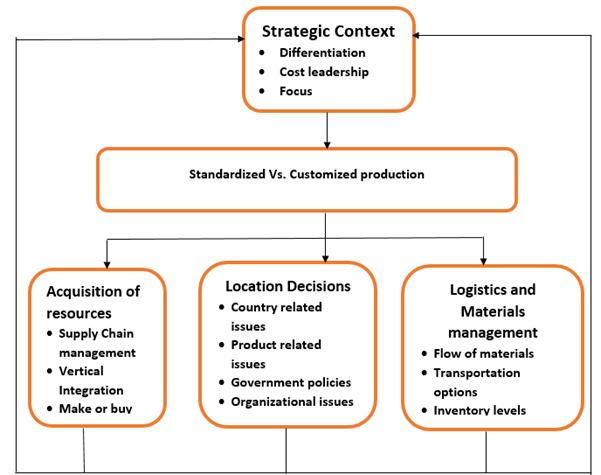International Production
Operations management is continually evolving. Operations management is the set of activities that create value in the form of goods and services by transforming inputs into outputs. Market globalization, technological development, the overcoming of international trade barriers and the boom in some undeveloped economies are modifying the economic structure of many countries and pushing companies to change their strategies and way of doing business. Fast change of corporate modus operandi involves the rethinking of operations management strategies. Innovative approaches to international new product development, sourcing, manufacturing and logistics are required to maintain and increase competitive advantage. These changes contribute to the operations management discipline new research topics that take into account the new order and the new economies that are shifting the world's economic equilibrium. The dynamics are even more enunciated if the actors involved belong to different economics scenarios. Paradoxically, internationalization processes are not limiting country-specific aspects but rather emphasising them. There are many country-specific cultural, legislative and infrastructural aspects that can influence future choices.
The Nature of International Operations Management
International operations management is myriad of actions used by an international business to alter different kinds of resource inputs (material, labour, and so forth) into final goods and services. A suitably designed and managed operating system plays a key role in determining product and service quality, and productivity. Additionally, operations management contributes a lot in determining how quickly a firm can respond to changes or new developments in technology, consumer tastes and preferences, pricing levels, competitive threats, and so forth.
The Strategic Context of International Operations Management: International operations management must be closely associated with a firm's strategy. In fact, the way in which a firm structures and manages its operations function is influenced by its strategy. A firm's strategy drives several operations management activities including location, facility design, and how logistics are managed.
International operations management is a difficult task as compared to domestic operations management. At global scale, managers must contend with suppliers from different countries, different government regulations wherever the firm does business, a heterogeneous market, disparate transportation facilities and networks, and relatively long distances. Several types of decisions must be made regarding where and how to produce goods and services. For example, a firm must decide where and how it will obtain needed resources for the operations management function. Additionally, the firm must make a number of location-related decisions such as where to build a plant or sales office. In addition, a firm must make decisions regarding transportation choices and inventory levels.
International operations management decisions, processes, and issues involving the creation of intangible services is referred to as service operations management.
International operation management process

Complexities of International Operations Management:
- Resources
- Location
- Logistics
Production management: There are three issues related to this process, international supply chain management, international facilities location, and international logistics.
Supply Chain Management and Vertical Integration.
Supply chain management is an array of processes and steps a firm uses to acquire the various resources it needs to create its products and services. Supply chain management is usually seen as a strategic issue because of its implications for product cost, product quality, and internal demands for capital. Vertical integration is extent to which a firm either delivers its own resources or obtains them from other sources.
In order to enter a foreign market, a multinational corporation has to decide the appropriate mode for organizing its foreign business activities (Hill, Hwang and Kim, 1990). Firms entering foreign markets choose different entry modes ranging from licensing and franchising to foreign direct investments (joint ventures, acquisitions, mergers and wholly owned new ventures) (Rasheed, 2005). Foreign market entry mode is described as 'an institutional arrangement that makes possible the entry of a company's products, technology, human skills, management, or other resources into a foreign country' (Root, 1987). There are several theoretical streams dealing with this choice, such as economic factors analysis, transaction cost analysis, the OLI model and behavioural theory.
To summarize, International Operations Management is primarily a transformation-related activities of an international firm.

